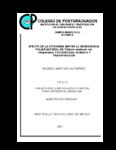Efecto de la citocinina bap en la senescencia foliar natural de Triticum aestivum var. Temporalera; Fotosíntesis, Rubisco y Tranpiración
Abstract
La senescencia foliar natural de Triticum aestivum var. Temporalera, fue retrazada con aspersiones de 6-bencilaminopurina (BAP) 0.1 mM, cada tres días durante 20 días en invernadero. La senescencia de las hojas control (agua) estuvo caracterizada por la perdida de clorofilas (88%) y proteínas solubles (96%), así como por una reducción de la población de plastidios (52.5%) a los 41 días después de la siembra (DDS). La concentración de xantofilas y carotenoides se redujo en un 53.9%, la tasa de asimilación de CO2 disminuyó en un 94%, la cual se correlaciono significativamente con la degradación de la LSU de Rubisco. El potencial hídrico ΨA disminuyó de -0.38 MPa a -0.62 MPa durante la senescencia; el potencial osmótico (Ψs) se incrementó de -1.3 MPa a -1.1 MPa, asociado a una pérdida de turgor en las células. En contraste BAP, mantuvo significativamente más alta la población de plastidios (74.5%), retuvo el 75.7% de la clorofila total y el 50% de la proteína soluble. Esta citocinina también promovió altos ΨA con respecto a los controles, disminuyendo en un 20 % (-0.48 MPa) con respecto al estadío inicial ó verde; incrementó el Ψs de -1.0 MPa a -1.10 MPa; el Ψt fue significativamente mayor que sus controles entre el día 31 y 41 DDS. La conductancia estomática (gs) se mantuvo en un 68% (864.9 mmol m-2 s-1) con respecto al valor inicial (1272 mmol m-2 s-1). La tasa de asimilación de CO2 (4 μmol de CO2 m-2 s-1) no presento valores significativamente diferentes de los observados en el estado verde pre-senescente a los 41 DDS. La proteína LSU de Rubisco retrasó su degradación, reteniendo el 50% de su cantidad total inicial a los 41 DDS. Este estudio demostró que el BAP retrasa la degradación varios de los elementos de la maquinaria fotosintética como; chl a, Chl b, x+c, población de plastidios, proteínas solubles y la LSU de Rubisco asociado a altos potenciales hídricos y altas tasas de asimilación de CO2.________Natural leaf senescence of Triticum aestivum cv. Temporalera was retarded by aspersions of 6-bencilaminopurine (BAP) 0.1 mM every 3 days, during 20 days in a greenhouse. Leaf senescence of control leaves (water) was characterized by the lost of chlorophylls (88%) and soluble proteins (96%), as well as by a reduction of the plastid population (52.5%) at the 41 days after sowing (DAS). Xanthophyll and carotenoid concentration were reduced in 53.9%, the rate of CO2 assimilation reduced in a 94%, which was significantly correlated to the degradation of the Rubisco protein (LSU). The water potential (ΨW) decreased of -0.38 MPa to -0.62 MPa during senescence, the osmotic potential (Ψs) increased from -1.3 MPa to -1.1 MPa, associated to a loss of cells turgor. In contrast BAP maintained significatively higher the plastids population (74.5%), retained 75.7% of total chlorophyll and the 50% of soluble proteins. These cytokinin also promoted high ΨW with respect to the controls, diminishing in 20% (- 0.48 MPa) respect to the initial or green stage; increased the Ψs from -1.0 MPa to -1.10 MPa; the Ψt were significantly higher than their respective controls between 31 to 41 DAS. The stomatal conductance (gs) stayed in 68% (864.9 mmol m-2 s-1) respect to initial value (1272 mmol m-2 s-1). The CO2 assimilation rate (4 μmol of CO2 m-2 s-1) did not show significantly different values from those of the green pre-senescent stage at the 41 DAS. The protein LSU of Rubisco delayed its degradation, retaining 50% of its initial amount to 41 DSA.
This study demonstrated that BAP delayed the degration of various elements of the photosynthetic machinery as: chl a, Chl b, x+c, plastid population, soluble protein and LSU of Rubisco associated to high water potential and high rate of CO2 assimilation.
Collections
- Tesis MC, MT, MP y DC [182]


